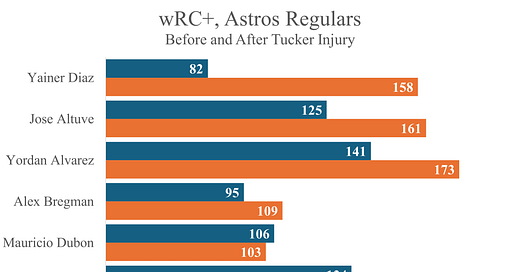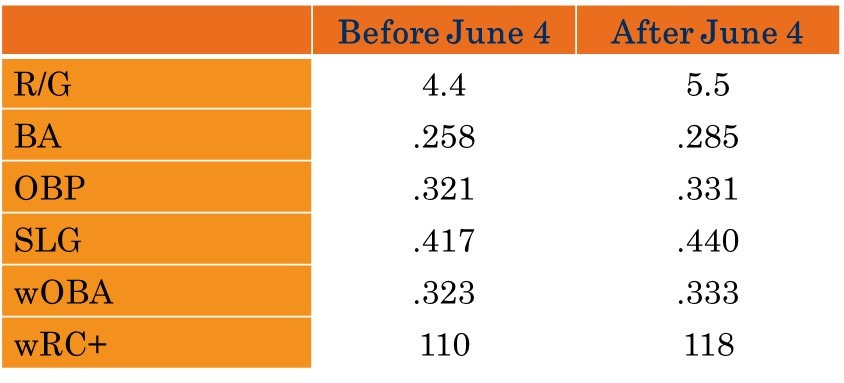The Astros Bats Have Gotten Hot Since Kyle Tucker Got Injured
We all worried about the Astros offense when their best hitter this season got injured. Apparently, we shouldn't have. The rest of the bats have picked up the slack.
Face it, you went to bed on June 3rd with a sense of dread. You were happy as an Astros fan that the team had won 7-4 that night against the Cardinals as Alex Bregman hit a tying homer to lead off the bottom of the 8th and Yainer Diaz hit go-ahead two run bomb later in the 8th.
The victory was nice, but it came with an ominous note. Kyle Tucker had to be removed from the game after he fouled a ball off of his leg. While initial reports described Tucker as “day-to-day” and Joe Espada said “I’m just encouraged that he’s walking around there and feeling OK,” as a veteran observer of Astros injury reports, you were concerned that the next step for Tucker would be amputation of his leg.
And without Tucker, you worried about the Astros lineup.
I certainly did. Ten days later, I wrote an article here headlined “The Astros Stars Are Not Playing Like Stars.” In it, I detailed how while Tucker was having a great year, the Astros overall offensive performance had declined in 2024 in large part because the Astros offensive stars—Jose Altuve, Yordan Alvarez, and Alex Bregman—were all performing worse than in 2023 and that Tucker’s breakout could not make up for that decline.
We Apparently Did Not Need to Worry
It turns out we should not have worried. The Astros offense was going to go on a hot streak and make up for the absence of Tucker in the lineup.
You can see the evidence in the chart below, which shows the Astros batting statistics before and after Tucker’s injury. It’s a tale of clear improvement.
The Astros batting average has increased from .258 to .285 and with the increase in base hits has come an increase in both on base percentage and slugging. The team’s wOBA (weighted On Base Average) has increased from .323 to .333.
The wRC+ stat is normalized to league average, which is measured at 100. Before Tucker’s injury, the Astros were 10% better at the plate than the average major league team. Since Tucker has left the lineup, they’ve been 18% better than league average. This is a particularly useful measure here, as offense across the league has gone up in June; warm weather helps baseballs travel further in the air.
Big Improvements From the Star Players
Losing Tucker, who has slashed .266/.395/.584 this season, is obviously a big blow to the Astros offense. They have made up for it by having a wide variety of players go on hot streaks in June.
Chas McCormick has finally broken out of his slump (.898 OPS since June 4); Trey Cabbage has been called up from AAA and is hitting well in a part-time role (.866 OPS) and Jon Singleton is getting on base frequently in his platoon role at first base (.364 OPS).
But the big story is the big bats. The top four guys in the current lineup—Jose Altuve, Alex Bregman, Yordan Alvarez, and Alex Bregman—have all hit better since Tucker went down. Some substantially better.
The chart below shows the weighted Run Created plus (wRC+) for the 7 Astros who are “qualified hitters.”1 Weighted Runs Created is a statistic which attempts “to quantify a player’s total offensive value.” The plus tells you that it is compared to league average, which is set at 100, and then scaled to the percentage better (or worse) than league average.
What the chart shows you is that the Astros top hitters have all improved since Kyle Tucker went down. The biggest mover is Yainer Diaz, who went from being 18% worse than league average before June 4 to 58% better than league average after it. Jose Altuve has improved from a 125 wRC+ to a 161; Yordan Alvarez has gone from 141 to 173.
Alex Bregman has had a more modest, yet clear improvement, going from a 95 wRC+ before Tucker’s injury to a 109 since then. But that has been very helpful taking up the slack for the Astros injured star.
It’s not all good news, but even the bad news is not all that bad. Mauricio Dubon has declined, but barely. With his glove and versatility, above average offensive contributions from Dubon make him a very valuable player. Jake Meyers has declined from a hot start, but I’ll absolutely take league average offensive production from someone with such excellent center field range as Meyers has.
The one clear downgrade has been from Jeremy Pena, who is in a big slump right now. He’s hitting .197 without a homer since June 4.
But overall, the Astros have stepped up offensively since Kyle Tucker went down with his injury. The improvement is across a wide variety of players, which has been essential to taking up the slack created by the absence of a star player like Tucker.
But the biggest contributions have been from the team’s biggest offensive stars. Both Yordan Alvarez and Jose Altuve were above average hitters before Tucker’s injury, but they have improved to the star levels we have seen from them in the plate in the past. Yainer Diaz has taken over as the team’s cleanup hitter since Tucker’s injury, and he has absolutely delivered, right when the team has needed him the most.
Of course the biggest impact of this offensive improvement has been in the standings. When Tucker fouled that ball off of his leg, the Astros were 26-34. Since then, they’ve won 16 games and lost only 7. They’ve played 8 series since the Tucker foul ball, and have won 7 of them. It’s far and away the best stretch of play from the Astros this season.
And with Tucker out of the lineup, it was right when we least expected it.
The standard for this is 3.1 at bats per game. Jake Meyers has the fewest at bats among this group at 75. It is notably higher than the Astros with the next most at bats (Jon Singleton at 44).





